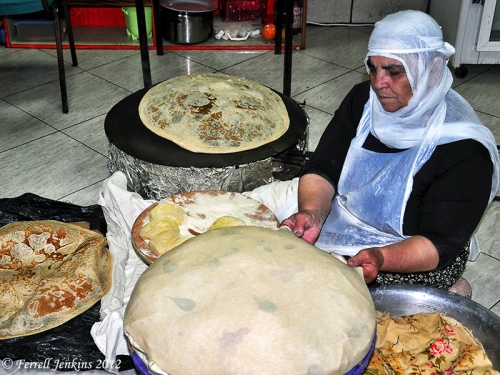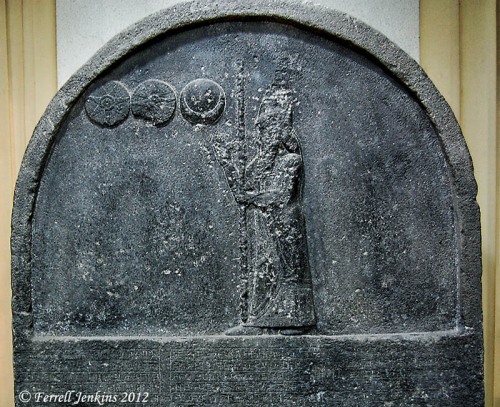Search This Blog
Monday, February 27, 2012
Where I Belong
Saturday, February 25, 2012
The big three: Nabonidus, Belshazzar and Daniel | Ferrell's Travel Blog
'via Blog this'
The big three: Nabonidus, Belshazzar and Daniel
Earlier this month we wrote about the significant kings of the Neo-Babylonian Empire. Here is a list of the articles in chronological order.
- Nabopolassar, father of Nebuchadnezzar, destroyed Nineveh here.
- The Kings of Babylon and Bible History here.
- Nebuchadnezzar, king of Babylon here.
- Evil-merodach (562-560) graciously freed Jehoiachin here.
- Nabonidus, the last king of Babylon here.
What about Belshazzar?
Belshazzar is called king several times in the Book of Daniel (5:1,9,30; 7:1; 8:1). He is referred to as the son of Nebuchadnezzar in Daniel 5:21-22. There may be many things we still do not know about the historical setting of Daniel, but we understand from Babylonian records that Nabonidus was the king of Babylon at this time (556–539 B.C.). How can it be said that Belshazzar is king, and how can Daniel be third in the kingdom (Daniel 5:7,16,29)?
Perhaps no book of the Old Testament has come under critical attack more than Daniel. As far back as the third century A.D. a Phoenician philosopher named Porphyry claimed the book of Daniel was written about 165 B.C. This is at the time of the oppression of Israel by the Seleucid ruler Antiochus Epiphanies. By dating the book which reports events of the 6th century B.C. to the second century, most of the prophetic elements are removed. This view has been followed by many liberal scholars. I recall learning it first from Robert H. Pfeiffer’s Introduction to the Old Testament (1941/48; pp. 748-781).
Even though information comes to light that suggests the feasibility of the biblical account, rarely do critical scholars acknowledge it.
An article by Dr. Alan R. Millard dealing with these issues appeared in Biblical Archaeology Review, May/June, 1985. At the time of this article, Millard was Rankin Senior Lecturer in Hebrew and Ancient Semitic Languages at the University of Liverpool in England. He explains the discovery of clay cylinders in southern Iraq by J. G. Taylor. Sir Henry Rawlinson was able to read the Babylonian cuneiform.
The inscriptions had been written at the command of Nabonidus, king of Babylon from 555 to 539 B.C. The king had repaired the temple tower, and the clay cylinders commemorated that fact. The inscriptions proved that the ruined tower was the temple of the city of Ur. The words were a prayer for the long life and good health of Nabonidus—and for his eldest son. The name of that son, clearly written, was Belshazzar!
Millard explains the significance of this discovery:
Here was clear proof that an important person named Belshazzar lived in Babylon during the last years of the city’s independence. So Belshazzar was not an entirely imaginary figure. This prayer, however, speaks of Belshazzar only as the king’s eldest son, not as king.
Professor Millar asks, “What, exactly, was Belshazzar’s position?”
Since 1854 several more Babylonian documents have been unearthed that mention Belshazzar. In every case, however, he is the king’s son or the crown prince; he is never given the title “king” in Babylonian. Although most scholars now admit that the author of the Book of Daniel did not invent Belshazzar, they still assert that, nevertheless, the Biblical author made a major mistake in referring to him as king.
Yet even that may not be quite right. In legal deeds from the sixth century B.C. the parties swear oaths by the gods and the king, according to a well-known and longstanding practice. In some of these deeds from the reign of Nabonidus, we find that the parties swear by Nabonidus and by Belshazzar, the king’s son. This formula, swearing by the king and his son, is unattested in any other reign in any documents yet uncovered. This suggests that Belshazzar may have had a special status. We know that during part of his father’s reign, Belshazzar was the effective authority in Babylon. The Babylonian texts reveal that Nabonidus was an eccentric ruler. While he did not ignore the gods of Babylon, he did not treat them in the approved way, and gave very considerable attention to the moon god at two other cities, Ur and Harran. For several years of his reign, Nabonidus did not even live in Babylon; instead he stayed at the distant oasis of Teima in northern Arabia. During that time, Belshazzar ruled in Babylon. According to one account, Nabonidus “entrusted the kingship” to Belshazzar. — BAR 11:03 (May/June 1985).
The small cuneiform foundation cylinder shown below, now in the British Museum, ends with a prayer in the name of Nabonidus and his son, Belshazzar.

Clay foundation cylinder naming Nabonidus and Belshazzar. British Museum ME 91128. Photo by Ferrell Jenkins.
Fant & Reddish provide this translation of the significant portion:
“As for me, Nabonidus, king of Babylon, save me from sinning against your great godhead and grant me as a present a life of long days, and as for Belshazzar, the eldest son my offspring, instill reverence for your great godhead (in) his heart and may he not commit any cultic mistake, may he be sated with a life of plenitude” (Lost Treasures of the Bible, 233).
Belshazzar was already second in the kingdom, serving as a co-regent with his absent father. He could offer Daniel nothing greater than “third ruler in the kingdom.”
A 1977 article by Millard, published in Evangelical Quarterly 49:2 (April-June 1977), is available on the BiblicalStudies.org.uk website here.
Numerous scholars have sought a harmony between the Babylonian and Biblical records in their introductory surveys and commentaries. These works should not be overlooked.
Thursday, February 23, 2012
Wishing the Bible was a self help book. | Stuff Christians Like – Jon Acuff
'via Blog this'
Wishing the Bible was a self help book.
February 22, 2012 in Uncategorized with 64 Comments
The Bible makes a pretty horrible self help book.
Sometimes, that’s what I want it to be. I want to see a picture of God on the back cover of the Bible wearing an approachable sweater next to a golden retriever who knows a few tricks but not so many that he’s obnoxious.
I want to crack open a chapter, read a few verses, get some action items and then walk away from my relationship with God. The truth is, most of my self improvement efforts are geared at getting my life running smoothly enough to where I don’t need God anymore. I’m not opposed to self help books or self improvement, Quitter could be categorized as one in some ways. But if I’m not careful, I tend to mutate my own effort into my own Emmanuel.
Perfection is my secret goal, not a deeper relationship with God.
But unfortunately, the Bible is refusing to cooperate.
Have you ever read the book of Jeremiah? I did during the two years I spent doing a one year walk through the Bible, and noticed a word I’m pretty unhappy about.
In chapter 1:7-8, God is calling Jeremiah and says this to him:
But the LORD said to me, “Do not say, ‘I am only a child.’ You must go to everyone I send you to and say whatever I command you. Do not be afraid of them, for I am with you and will rescue you,” declares the LORD.
The word that stuck out to me was “rescue.”
I’ve always read that verse like this:
“Do not be afraid of them, for I am with you and will make sure life goes so well that you never need to be rescued.”
I’ve always thought that a sign that you are doing God’s work, that you have listened to His voice and made the right the decision is that things are peaceful and easy. God is there after all, shouldn’t that verse say, “Do not be afraid of them, for I am with you and will comfort you?”
But it doesn’t say that, it says “rescue.” It reads like God is saying, “Look, you need to go do what I am asking you to do and it won’t be easy. I’m not calling you to safety and comfort, I’m asking you to go into a situation that’s going to be dangerous and difficult. Where I am calling you will require rescue, but I will provide it. That’s what I am going to give you, rescue. But in order to give you the gift of rescue, I need you to go somewhere that requires it and I’m going to be upfront, that won’t be fun all the time. Because if it was, rescue wouldn’t be necessary and that’s the gift I want to give you. So ….”
I don’t know where you are or what God’s doing in your life right now but I do know this, if you want to receive the gift of rescue, which I think is one of God’s favorite gifts to give us, you have to go somewhere and do something that requires it.
Does that mean we won’t know peace and comfort during the adventures God calls us on? Does that mean danger and hardship are the only indications we’re in God’s will for our lives? Does that mean the things God calls us to will be miserable? Not at all, I think God calls us to the things he uniquely and joyfully prepared us to do and there is deep, true, lasting peace amidst that.
But I do think that the Bible makes a horrible self help book and it never promises that upon following all it’s tenet’s we won’t have trouble. If anything, we’re promised in this world that we will have trouble, but God has overcome it.
And that is the best kind of rescue.
Monday, February 20, 2012
Baking bread in Bible times | Ferrell's Travel Blog
'via Blog this'
The Druze are especially noted in Israel for baking bread on a convex griddle. There are Druze villages on Mount Carmel and in the Golan Heights where the border with Israel and Syria come together. The photo below slows a woman preparing the dough for baking at a restaurant in the north of the Golan Heights at Birket Ram.
She will first place the dough on a rounded cushion which looks like a pillow (at the bottom of the photo).
After that she will turn it over on the griddle at the top of the photo. There you see bread cooking. To the left there is bread that has been taken from the griddle. Your chosen ingredients of meal and/or vegetables will be rolled in the thin bread.
I certainly am not an expert on cooking, nor even an expert on how this type of cooking might compare with some bread baking in Bible times. Ovens were often used by people of the Bible world, but some bread was cooked on a plate or griddle made of clay or iron.
King and Stager say,
“When a griddle (mahabat) of clay or iron (Ezek. 4:3) was used, it was set on stones over a pit in which a fire was kindled; then the dough was baked directly on the griddle” (Life in Biblical Israel, 66).
There are a few biblical references in which this type of griddle seems to be in mind.
And if your offering is a grain offering baked on a griddle, it shall be of fine flour unleavened, mixed with oil. (Leviticus 2:5; see also 6:21; 7:9 ESV)
For a visual aid, Ezekiel was told to take an iron griddle (plate, frying pan) and use it as an iron wall between himself and the city.
And you, take an iron griddle, and place it as an iron wall between you and the city; and set your face toward it, and let it be in a state of siege, and press the siege against it. This is a sign for the house of Israel. (Ezekiel 4:3 ESV)
Holladay’s Hebrew lexicon defines the Hebrew word for griddle as “(metal)plate, griddle for roasting & frying.”
I would write more, but I think I will go eat.
Memory Verse?! NNnnnooooooooooo!
“I have hidden your word in my heart that I might not sin against you.” (Psalm 119:11)
Monday, February 13, 2012
Pontius Pilate - The Man Who Washed His Hands
 |
| The Pilate Inscription at Caesarea |
 |
| Bronze coin of Pontius Pilate, Procurator of Judaea. Roman, AD 30/1 From Judaea (modern Israel). British Museum. |
Sunday, February 12, 2012
Nabonidus, the last king of Babylon — 556–539 B.C. | Ferrell's Travel Blog
'via Blog this'
Nabonidus, the last king of Babylon — 556–539 B.C.
Evil-Merodach (562-560 B.C.) was assassinated by Nergal-Sharezer, who ruled as king of Babylon for four years. Nothing about his reign is recorded in the Bible, but he is mentioned in Jeremiah 39:3 and 13 from the time of the destruction of Jerusalem (587 B.C.). At that time he served as one of the officials of Nebuchadnezzar.
After four years on the throne, Nergal-Sharezer was followed by his son,Labaši-Marduk, who ruled only 9 months.
Nabonidus, who is not named in the Bible, came to the throne in 556 B.C. According to Wiseman the king,
… campaigned in Syria and N Arabia, where he lived at Tema for 10 years while his son BELSHAZZAR acted as co-regent in Babylon. About 544 his people and the kings of Arabia, Egypt and the Medes being favourably disposed, Nabonidus returned to his capital…, but by this time the country was weak and divided. (New Bible Dictionary (3rd ed.), 115).
The mother of Nabonidus was made a high priestess in the temple of Sin at Harran. Our first photo shows the top of a stela from Harran. Nabonidus is portrayed standing before symbols of the principle gods he served. Incidentally, the museum at Sanliurfa, Turkey, has a nice collection of archaeological artifacts tastefully displayed.
The next photo shows a terracotta foundation cylinder of Nabonidus. The sign accompanying the cylinder in the British Museum tells us that “this document records the reconstruction of temples to the Moon-god at Harran and to the Sun-god and the goddess Amunitum at Sippar.”
In a future post we plan to comment on the relationship of Nabonidus andBelshazzar.




